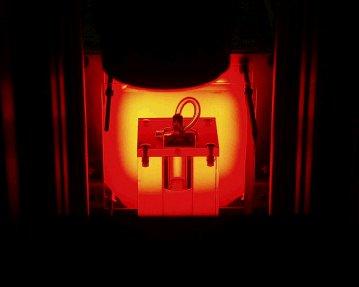experiments with storable liquids
experimental setup
Microgravity drop tower experiments are carried out investigating the dynamic behaviour of menisci upon step reduction in gravity. Fig. 1 shows the dropcapsule, where the main experimental setup on the middle platform consists of a cuvette (with diameter D), located within a perspex cube, a high-speed camera system and an illumination device. The cuvette is accurately manufactured of a solid cubic perspex block and carefully cleaned before the experiment. The filling of the cuvette with fluid is obtained by connecting the cuvette with a large glass syringe (acting as a reservoir), which is driven of a step motor, located on the lower platform. A slow filling just before the drop of the capsule is necessary to guarantee a uniform boundary and initial condition at the contact line. Two highspeed CCD cameras, which can record up to 500 frames per second, observe the surface reorientation with a pixel resolution of 0.02-0.09 mm, depending on the chosen configuration. Homogenous background illumination is achieved using an adjustable LED array with light diffusors. Fig. 2 shows a detailed front view on the cuvette, sealed with a cover plate and a breather hose to prevent impurities.


experimental results
Using the above mentioned high-speed camera system with a recording frequency of 500 fps over an experimental time of aprox. 5 seconds, more than 2500 digital images are obtained for each camera view (for a recording frequency of 250 fps 1375 digital images are recorded). This high amount of data requires the application of a digital image processing system to detect the free surface shape for each picture and thus the reorientation of the meniscus over time. A transformation of the pixel coordinate-system into the real coordinate system allows to plot characteristic points (e.g. the contact point at the solid wall or the axial center point) over time. The determination of the dynamic contact angle as a function of time, moving distance and velocity enables us to validate models for the dynamic contact in the literature with the new experimental data. Moreover, the knowledge of the movement of the entire meniscus shape for this benchmark configuration is helpful for the comparison of experimental data with numerical results and to define the appropriate bondary conditions for numerical calculations.
publications
Michaelis, M.: Kapillarinduzierte Schwingungen freie Flüssigkeitsoberflächen, Fortschr.-Ber. VDI Reihe 7 Nr. 454. Düsseldorf: VDI Verlag 2003.
Michaelis, M., Dreyer, M.E., Rath H.J.: Experimental Investigation of the Liquid Interface Reorientation Upon Step Reduction in Gravity, In: Sadhal, S.S. (Editor): Microgravity Transport Processes in Fluid, Thermal, Biological, and Material Sciences, New York Academy of Sciences, 974 (2002), pp. 246-260
The funding of the drop tower flights and the funding of the research project by the German Federal Ministry of Education and Research (BMBF) through the German Aerospace Center (DLR) under grant numbers 50WM0241 and 50WM9901 are gratefully acknowledged.


 "
"